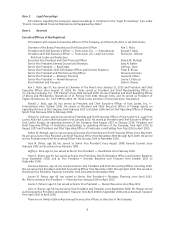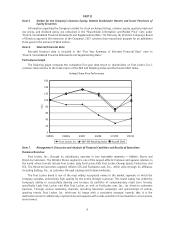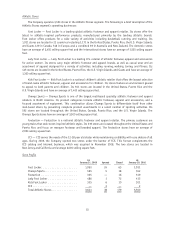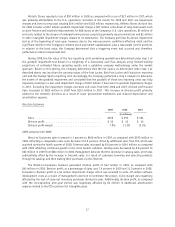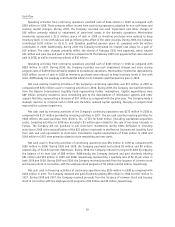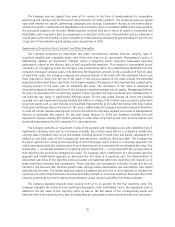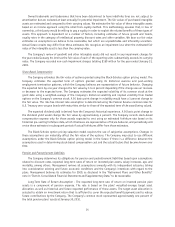Foot Locker 2009 Annual Report Download - page 36
Download and view the complete annual report
Please find page 36 of the 2009 Foot Locker annual report below. You can navigate through the pages in the report by either clicking on the pages listed below, or by using the keyword search tool below to find specific information within the annual report.
2008 compared with 2007
Direct-to-Customers sales increased 7.1 percent to $390 million in 2008, as compared with $364 million in
2007, reflecting a comparable-store sales increase of 1.0 percent and additional sales from CCS, which was
acquired during the fourth quarter of 2008. Internet sales increased by 12.2 percent to $322 million, as compared
with 2007. Catalog sales decreased by 11.7 percent to $68 million in 2008 from $77 million in 2007. Management
believes that the decrease in catalog sales, which was substantially offset by the increase in Internet sales, is a
result of customers browsing and selecting products through its catalogs and then making their purchases via the
Internet.
The Direct-to-Customers business generated division profit of $43 million in 2008, as compared with
$40 million in 2007. Division profit, as a percentage of sales, was 11.0 percent in 2008 and 2007. The increase in
division profit reflects the accretive effect of the acquisition of CCS.
Liquidity and Capital Resources
Liquidity
Generally, the Company’s primary source of cash has been from operations. The Company generally finances
real estate with operating leases. The principal uses of cash have been to finance inventory requirements, capital
expenditures related to store openings, store remodelings, information systems, and other support facilities,
retirement plan contributions, quarterly dividend payments, interest payments, other cash requirements to
support the development of its short-term and long-term operating strategies, and to fund other working capital
requirements.
Management believes its cash, cash equivalents, future cash flow from operations, and the Company’s current
revolving credit facility will be adequate to fund these requirements. The Company may also from time to time
repurchase its common stock or seek to retire or purchase outstanding debt through open market purchases,
privately negotiated transactions or otherwise. Such repurchases, if any, will depend on prevailing market
conditions, liquidity requirements, contractual restrictions and other factors. The amounts involved may be
material. On February 16, 2010, the Company’s Board of Directors approved the extension of the Company’s 2007
common share repurchase program for an additional three years in the amount of $250 million.
Maintaining access to merchandise that the Company considers appropriate for its business may be subject
to the policies and practices of its key vendors. Therefore, the Company believes that it is critical to continue to
maintain satisfactory relationships with its key vendors. The Company purchased approximately 82 percent in
2009 and 80 percent in 2008 of its merchandise from its top five vendors and expects to continue to obtain a
significant percentage of its athletic product from these vendors in future periods. Approximately 68 percent in
2009 and 64 percent in 2008 was purchased from one vendor — Nike, Inc.
Planned capital expenditures for 2010 are approximately $103 million, of which $65 million relates to
modernizations of existing stores and new store openings, and $38 million reflects the development of
information systems and other support facilities. In addition, planned lease acquisition costs related to the
Company’s operations in Europe are $7 million. The Company has the ability to revise and reschedule the
anticipated capital expenditure program, should the Company’s financial position require it.
Any material adverse change in customer demand, fashion trends, competitive market forces or customer
acceptance of the Company’s merchandise mix and retail locations, uncertainties related to the effect of
competitive products and pricing, the Company’s reliance on a few key vendors for a significant portion of its
merchandise purchases, and risks associated with foreign global sourcing or economic conditions worldwide
could affect the ability of the Company to continue to fund its needs from business operations.
18


